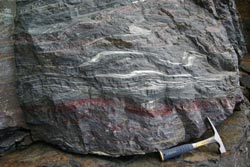New study shows: Vast landmasses already existed 2,700 million years ago

The Temagami Iron Formation: an archive of 2,700-million-year-old seawater<br>Copyright: M. Bau / Jacobs University Bremen <br>
A new study by Jacobs University Bremen, in close cooperation with the University of Bonn and the University of Cologne, shows that 2,700 million years ago vast landmasses already existed on earth. The research results have now been published in science journal Geology. (DOI: 10.1130/G35014.1).
The question when vast landmasses rose above sea-level remains an issue of debate within the science community. Computer simulations, for example, suggested that 2,500 million years ago only 3% of the Earth’s surface area was dry.
A new geochemical approach to address this issue has now been developed by Michael Bau, Professor of Geosciences at Jacobs University Bremen, his Ph.D. student Sebastian Viehmann and collaborators Dr. Elis Hoffmann (University of Bonn) and Prof. Carsten Münker (University of Cologne), who studied the distribution of rare trace elements and the isotopic composition of hafnium (Hf) and neodymium (Nd) in ancient seawater.
Analyzing unusually pure iron-rich sedimentary rocks (banded iron-formation, BIF) from Temagami, Canada, which are an archive of 2,700-million-year-old seawater, the researchers were able to extend the Hf isotope record of seawater back in time to the Early Earth’s ocean.
The Temagami BIF shows that 2,700 million years ago, seawater was anomalously enriched in the radiogenic Hf-176 isotope, whereas its Nd isotopic composition was normal. This reveals that the same decoupling of Hf and Nd isotopes, which is observed in the modern ocean, did already persist 2,700 million years ago.
Prof. Bau explains: “Seawater that is enriched in Hf-176 is produced when rocks at the Earth’s surface are subjected to terrestrial erosion and weathering. The observed decoupling of Hf and Nd isotopes recorded in the Temagami BIF indicates that already 2,700 million years ago, large areas of dry land were emerged above sea-level and exposed to wind and rain.”
The results of this study are now published in scientific journal Geology.
Decoupled Hf-Nd isotopes in Neoarchean seawater reveal weathering of emerged continents
Authors: Sebastian Viehmann, J. Elis Hoffmann, Carsten Münker, Michael Bau
Contact:
Michael Bau | Professor of Geosciences
Tel.: +49 421 200-3564 | Email: m.bau@jacobs-university.de
Weitere Informationen:
http://geology.gsapubs.org/content/early/2013/12/12/G35014.1.abstract
Media Contact
More Information:
http://www.jacobs-university.deAll latest news from the category: Earth Sciences
Earth Sciences (also referred to as Geosciences), which deals with basic issues surrounding our planet, plays a vital role in the area of energy and raw materials supply.
Earth Sciences comprises subjects such as geology, geography, geological informatics, paleontology, mineralogy, petrography, crystallography, geophysics, geodesy, glaciology, cartography, photogrammetry, meteorology and seismology, early-warning systems, earthquake research and polar research.
Newest articles

Properties of new materials for microchips
… can now be measured well. Reseachers of Delft University of Technology demonstrated measuring performance properties of ultrathin silicon membranes. Making ever smaller and more powerful chips requires new ultrathin…

Floating solar’s potential
… to support sustainable development by addressing climate, water, and energy goals holistically. A new study published this week in Nature Energy raises the potential for floating solar photovoltaics (FPV)…

Skyrmions move at record speeds
… a step towards the computing of the future. An international research team led by scientists from the CNRS1 has discovered that the magnetic nanobubbles2 known as skyrmions can be…




















